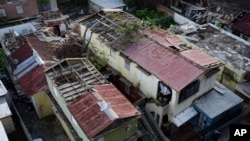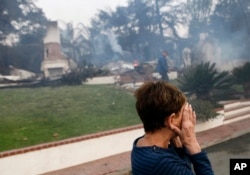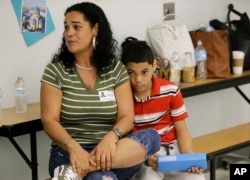The year has been a tough one for Puerto Ricans, Floridians, Texans and Californians, and recovery efforts continue for those three areas hit by hurricanes and one, California, struggling to contain wildfires. In a year of disasters, even the Federal Emergency Management Agency is struggling to cope.
At a hearing before the House Appropriations Subcommittee November 30, FEMA head Brock Long asked lawmakers for supplemental funding to handle its operations after a year studded with natural disasters.
Long told lawmakers that Hurricanes Harvey, which hit Texas, Irma, which targeted Florida, and Maria, which walloped the U.S. territories of Puerto Rico and the U.S. Virgin Islands, added to the ongoing California fires “have compelled FEMA to push its limits.”
Long noted that about 25.8 million people were affected by the three hurricanes, which took place in rapid succession in August and September. He said that as of November 13, more than 4½ million storm survivors had registered for FEMA assistance. He asked for $23.5 billion for FEMA’s disaster relief fund for fiscal 2018 to help with continuing recovery efforts. He said the agency is “committed to the long-term recovery of all impacted individuals as well as conducting this recovery in a fiscally responsible and prudent manner.”
Puerto Rico response criticized
But FEMA has been criticized for its response to the crisis in the U.S. territories of Puerto Rico and the U.S. Virgin Islands, Caribbean islands that took a double hit from Irma and Maria within the space of a month. Three months after the second storm, only 65 percent of Puerto Rico has its power restored, thanks to an aging infrastructure and bungled reconstruction deals. The Army Corps of Engineers now estimates that power may not be fully restored to all communities until May.
Puerto Rican newspaper El Nuevo Dia reported that protests broke out in the municipalities of Aguas Buenas and Trujillo Alto Thursday, among frustrated residents who want the lights back on.
Vox News, citing statistics by the research firm Rhodium Group, reports that Puerto Rico is now the site of the longest blackout in U.S. history in terms of lost customer-hours of service.
FEMA has reported that more than 450 people are still living in shelters in Puerto Rico, and it is still distributing tarps, food and water to some communities. More troubling, Florida officials say more than 269,000 people have arrived in Florida from Puerto Rico since the storm, and some 10,000 Puerto Rican children have enrolled in Florida schools.
The Center for Puerto Rican Studies at City University of New York says the exodus is likely not over. It estimates that 470,335 Puerto Ricans will leave the island by the end of 2019, driven out by poor services and slow recovery. Experts fear that many of the displaced may not return to the island; as full U.S. citizens, they are legally able to move anywhere within the United States.
Virgin Islands overshadowed
In the nearby U.S. Virgin Islands, often overshadowed by its more populous neighbor, conditions are similar. The San Juan Daily Star reports about half of electrical customers remain without power, and about one quarter of the tourism-reliant island still lacks mobile phone service.
FEMA reported Thursday that more than $870 million in federal funds have been provided to survivors of Irma and Maria in U.S. territories, including grants, low-interest loans, and flood insurance claims.
But the tough times may get tougher before they ease: FEMA’s voucher program for displaced storm victims expires January 15.
Death toll
One more major point on which U.S. officials have been criticized is the storm-related death toll in Puerto Rico. The official total was placed at 64, but both Vox news and the New York Times published analyses in the past week comparing historic death rates from September and October with the death tolls from this year. They both found more than 1,000 more deaths occurred this year than in previous years, and both publications attributed the higher tolls to the stresses of storm recovery.
















